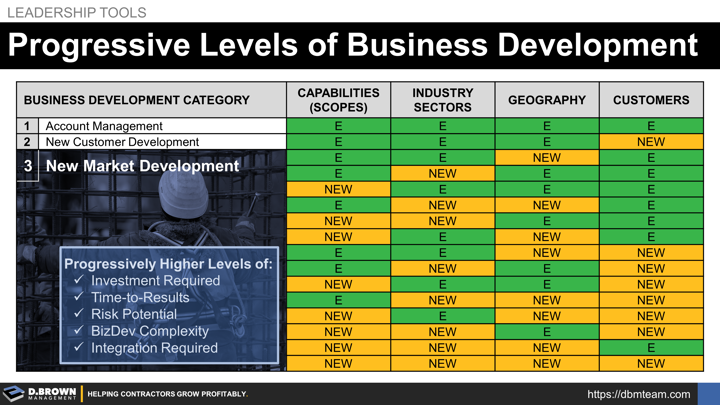As a contractor navigates the stages of growth and makes different strategic choices about industry sectors, scopes of work (capabilities), geography, and customers, the business development processes and people must also evolve. This includes both major market choices and strategic experiments.
Business Development can be defined as the process of creating new business opportunities through targeted networking, education, and awareness-building activities.
Business Development is not an exact science so outcomes are best measured in leading and lagging measures, which should be clearly defined in all job roles that are a part of business development including dedicated business developers.
- Lead Measures: Activity levels including outreach communications, meetings, and events.
- Lag Measures: Opportunities developed with at least 80% of them being aligned with strategy and operations and at a volume that develops the right pipeline size.
Business Development may be involved in, but is not directly responsible or accountable for:
- Decision to Pursue the opportunity given factors including strategic fit and operational fit as compared to all other opportunities in the pipeline.
- Accurate Estimation of quantities and cost given factors including scope, schedule, and conditions.
- Sell Pricing given factors including strategic fit, operational fit, competitive landscape, customer, and other opportunities in the pipeline.
- Negotiation of the final deal including terms.
Business Development can be broken into three broad categories that are progressively more difficult.
- Account Management: This is an operational support function focused on existing customers in an existing market ensuring routine communication. There is an element of account management built into many roles including estimator, project manager, and senior leadership. Depending on the market and size of the contractor, this is sometimes a dedicated function to help coordinate relationships across functions.
- New Customer Development (Existing Markets): This is a combination of an operational support and a strategic support function. The biggest difference is "Degree of New" for the customer. For instance, if you make ice and currently sell ice to customers in Arizona then identifying and selling to new customers in Arizona is very different than if you had a crazy strategy on how to "Sell Ice to Eskimos" in which case that would be more of a strategic support function. There are usually many times more customers in existing markets than a contractor knows. It is one of the four truths of business development.
- New Market Development: This is a strategy support function and gets progressively more difficult with each "Degree of New," which can be looked at as a combination of how many things are new as outlined in the table above. Selling a whole new capability for the company that is in development to a new customer is a challenging balancing act on its best day, requiring patience and tight integration between operations and business development.
Since business development is one of the first things that every contractor does when starting the company, the nuances of the capability are often overlooked. Business development at a Stage 4 contractor looks nothing like business development at a first-generation contractor navigating the first few stages of growth. To navigate from Stage 5 to Stage 6+ with Sustainability in Scaling and Succession, both the strategic decision making and business development processes are built into the systems and structure including operating rhythms and feedback loop.
The principles are the same, but the job roles, responsibilities, accountabilities, tools, and information flow are completely different. Knowing when and how to change when navigating each stage is critical.

